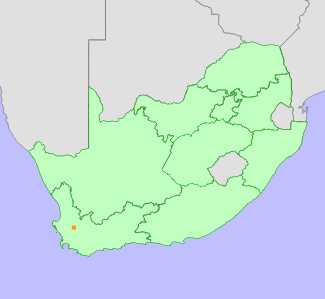|
Scientific Name | Aspalathus sulphurea R.Dahlgren |
Higher Classification | Dicotyledons |
Family | FABACEAE |
National Status |
Status and Criteria | Critically Endangered B1ab(ii,iii,iv,v)+2ab(ii,iii,iv,v) |
Assessment Date | 2022/11/21 |
Assessor(s) | B. du Preez & D. Raimondo |
Justification | A restricted Fynbos endemic with an extent of occurrence (EOO) and area of occupancy (AOO) of 8 km². Only one location and subpopulation has been recorded in the past 50 years. The population declining due to ongoing habitat loss to fruit orchard cultivation and degradation of its habitat as a result of invasive alien plants. It therefore qualifies for Critically Endangered under criterion B. |
Distribution |
Endemism | South African endemic |
Provincial distribution | Western Cape |
Range | This species occurs in the northern parts of the Agter-Witzenberg valley between Skurweberg and Groot Winterhoek Mountains, in the Western Cape Province of South Africa. |
Habitat and Ecology |
Major system | Terrestrial |
Major habitats | Winterhoek Sandstone Fynbos |
Description | It grows in montane fynbos on low slopes. |
Threats |
| It is only known from two collections, and appears to be restricted to lower slopes and valley areas which have been extensively transformed for the cultivation of deciduous fruit. Between 50 and 70% of former habitat has been lost to orchard cultivation. There are also alien plants (Pinus sp. And Acacia longifolia) present at the type locality at Visgat. |
Population |
Known from the type collection made in 1940 at Visgat and a recent collection in 2021 at Sandvlakte. The type locality is highly likely to be extinct given that the majority of suitable habitat has been transformed for fruit orchards. However the site has not yet been extensively searched and it is unknown if the subpopulation is still extant there, however given the high levels of tranformation for the purposes of this assessment it is assumed extinct. At Sandvlakte there were 400 plants observed in a 100 x 100 m area. While many other places of suitable habitat were searched in 2021 only this one subpopulation was found. The population is declining as a result of habitat degradation to invasive alien plants ongoing habitat transformation for orchard cultivation.
|
Population trend | Decreasing |
Assessment History |
Taxon assessed |
Status and Criteria |
Citation/Red List version | | Aspalathus sulphurea R.Dahlgren | Data Deficient | Raimondo et al. (2009) | | Aspalathus sulphurea R.Dahlgren | Insufficiently Known | Hilton-Taylor (1996) | | Aspalathus sulphurea R.Dahlgren | Uncertain | Hall et al. (1980) | |
Bibliography |
Dahlgren, R. 1988. Crotalarieae (Aspalathus). In: O.A. Leistner (ed). Flora of southern Africa 16 Fabaceae, Part 3 Papilionoideae, Fascicle 6:1-430. National Botanical Institute, Pretoria.
Goldblatt, P. and Manning, J.C. 2000. Cape Plants: A conspectus of the Cape Flora of South Africa. Strelitzia 9. National Botanical Institute, Cape Town.
Hall, A.V., De Winter, M., De Winter, B. and Van Oosterhout, S.A.M. 1980. Threatened plants of southern Africa. South African National Scienctific Programmes Report 45. CSIR, Pretoria.
Hilton-Taylor, C. 1996. Red data list of southern African plants. Strelitzia 4. South African National Botanical Institute, Pretoria.
Raimondo, D., von Staden, L., Foden, W., Victor, J.E., Helme, N.A., Turner, R.C., Kamundi, D.A. and Manyama, P.A. 2009. Red List of South African Plants. Strelitzia 25. South African National Biodiversity Institute, Pretoria.
|
Citation |
| du Preez, B. & Raimondo, D. 2022. Aspalathus sulphurea R.Dahlgren. National Assessment: Red List of South African Plants version 2024.1. Accessed on 2025/10/26 |
 Comment on this assessment
Comment on this assessment


